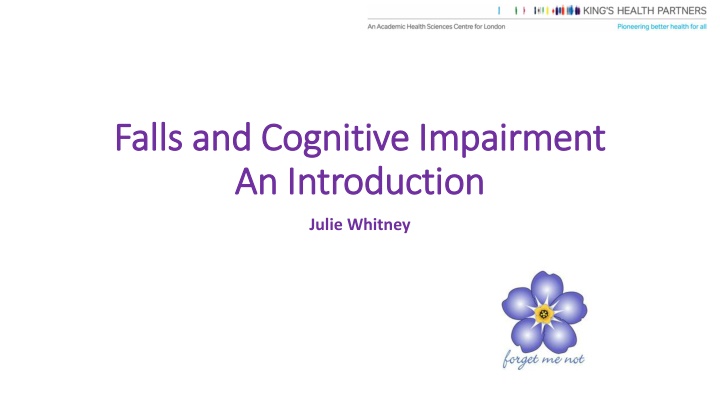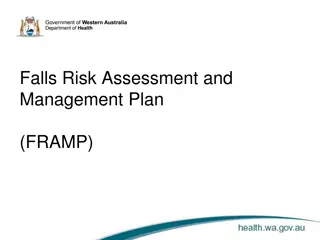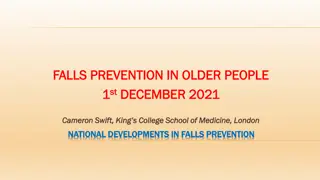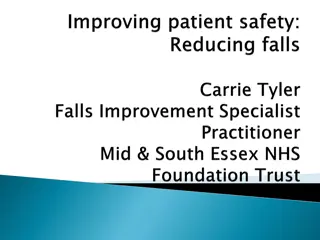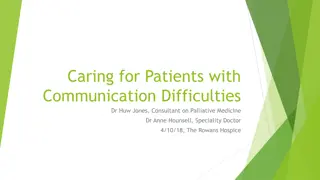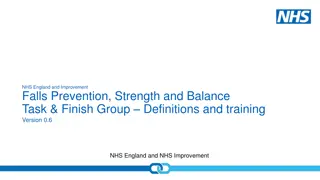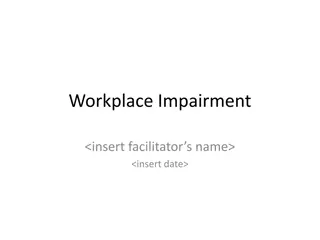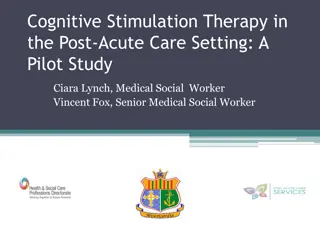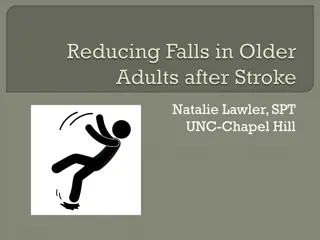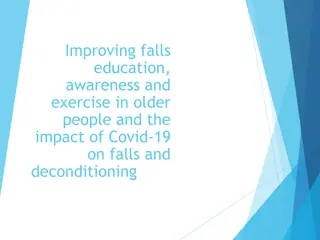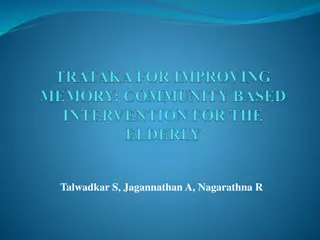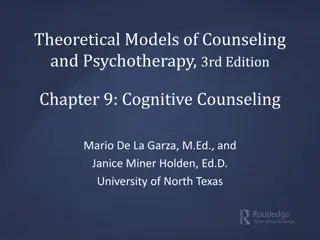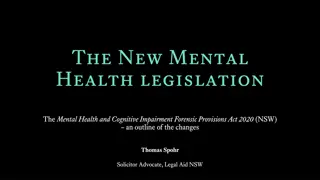Falls and Cognitive Impairment
Falls in individuals with cognitive impairment pose a significant risk, leading to higher rates of injuries and adverse outcomes. Factors such as gait impairments, medication use, and cognitive decline contribute to increased fall risk. Understanding these risks is crucial for effective prevention strategies and better care for affected individuals.
Download Presentation

Please find below an Image/Link to download the presentation.
The content on the website is provided AS IS for your information and personal use only. It may not be sold, licensed, or shared on other websites without obtaining consent from the author.If you encounter any issues during the download, it is possible that the publisher has removed the file from their server.
You are allowed to download the files provided on this website for personal or commercial use, subject to the condition that they are used lawfully. All files are the property of their respective owners.
The content on the website is provided AS IS for your information and personal use only. It may not be sold, licensed, or shared on other websites without obtaining consent from the author.
E N D
Presentation Transcript
Falls and Cognitive Impairment Falls and Cognitive Impairment An Introduction An Introduction Julie Whitney
Falls and cognitive impairment Falls and cognitive impairment Twice as likely to fall in a year More likely to be a multiple faller More likely to have injurious falls 3-4 times more likely to sustain a hip fracture 20% those who sustain a hip fracture have dementia 40% of those who sustain a hip fracture have cognitive impairment A faller with cognitive dementia / CI more likely to experience poor outcomes after a fall (functional impairment, institutionalisation, death)
Why do people with cognitive impairment fall? Why do people with cognitive impairment fall? Higher prevalence of risk factors Cognition specific risk factors
Higher prevalence of risk factors Higher prevalence of risk factors More likely to have sensori-motor, gait and balance impairments Shorter step length, more gait variability, slower gait speed, poorer obstacle clearance Changes in gait and balance found to precede gait and balance instability Increased dual task costs More likely to be prescribed psychotropic medications More sedentary behaviour Increased prevalence of fear of falling More autonomic dysfunction / orthostatic hypotension
Specific risk factors Specific risk factors Global cognition associated with increased risk Visuospatial function Executive function Processing speed Attention Many BPS are associated with increased risk: apathy, sleep disturbance, agitation, psychosis, hallucinations impulsivity and wandering Depression Anxiety
What about hospital inpatients? What about hospital inpatients? 25% acute hospital inpatients have dementia Delirium: 20-30% acute medical wards 10-50% people having surgery 70-90% falls in inpatient setting, patients had identified delirium
Delirium Delirium Delirium (sometimes called 'acute confusional state') is a common clinical syndrome characterised by disturbed consciousness, cognitive function or perception, which has an acute onset and fluctuating course. Acute impairment in attention and judgment, impulsivity, agitation Acute impairment in gait and balance Challenge delirium type: Hyperactive Hypoactive Mixed
Interventions to address Interventions to address falls in CI falls in CI Impaired cognition Exercise (with more supervision) Single interventions to address risk factors Multi-factorial risk assessment Holistic interventions address more general well-being Carer training Frailty Exercise Single interventions to address risk factors Exercise / activity / SB reduction Multi-factorial assessment and intervention Comprehensive geriatric assessment
Exercise interventions in cognitive impairment Exercise interventions in cognitive impairment Possible to improve gait and balance parameters Small low quality studies, heterogeneity Evidence that it reduced falls in community dwelling populations Cochrane found 67% exercise trials exclude people with cognitive impairment Sherrington et al (2016) community populations
Other interventions Other interventions in community dwellers in community dwellers Multi-factorial studies in community dwelling populations = more than half the studies exclude people with cognitive impairment Some evidence that Donepezil decreases the risk of falls
Interventions in care homes Interventions in care homes 70% people in care homes have dementia / CI Multi-factorial: supervised exercise, medication review, vitamin D supplementation, continence management and staff education Unclear evidence as to whether severity of cognitive impairment impacts on this No evidence that exercise alone is effective in care homes
Hospital inpatients Hospital inpatients Few studies focused on cognitive impairment Multi-factorial interventions effective in sub-acute / mixed settings but not in acute settings (where delirium incidence is higher) Multi-component interventions for delirium appear to reduce falls No evidence for movement sensors
What might work? What might work? Risk factors Agitation Impulsivity Wandering Poor attention Possible interventions Meeting basic psychological needs
Meeting basic psychological needs Meeting basic psychological needs Address pain, pressure, toileting, poor seating, hunger, thirst, stiffness, environment Own clothes, belongings, This is me . Include in ward activity, greet and speak to regularly Carer presence, dolls / other item MEANINGFUL ACTIVITY Kitwood
Meaningful activity Meaningful activity Needs to be graded to cater for different abilities PLANNED High level, can do most activities with support EXPLORATORY Will need more support, help with planning and ordering SENSORY Chose activities that are sensory based not task focused (rummage boxes / bags) REFLEX Massage, mobiles, scent therapy, music
Summary Summary Increased risk of falls and fractures in people with cognitive impairment Cognitive impairment has been an exclusion criterion in many falls studies Evidence that exercise is effective in community dwellers who are not severely frail and with intensive support Multi-factorial interventions have a small effect in care homes Evidence for efficacy of interventions in hospital limited potential for good delirium care Approach probably needs to consider the risk factors specific to cognitive impairment
